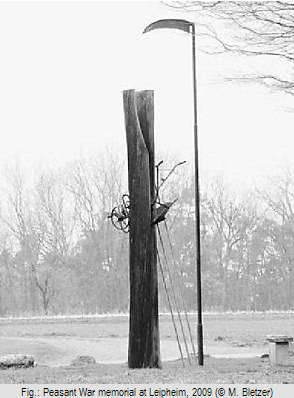Since destinies other than those of military leaders were seldom recorded in pre-modern wars, the fate of the common fighting man is mainly a subject of archaeological research. If historical archaeology aims to "challenge and reassess the apparent familiarity of the recent past…and to address themes and social groups that [are] undocumented" [2], then the forgotten participants in past conflicts surely merit attention. For studies of popular resistance in feudal and colonial societies this holds especially true due to the hostile tenor of written sources. With violent suppression and criminalization being the official legacy of many resistance movements, archaeology can help examine conventional attitudes towards events which people in the past may have been able to commemorate only selectively or clandestinely [3].
 A good example is the Peasants' War of 1525. Numerous historical studies illustrate the sociopolitical complexity and lack of clear-cut battle lines in this series of regional uprisings in southern Germany and adjacent areas in the mid-1520s. Some historians use the contemporary term 'common man' to reflect the social diversity in the rebel camp. In the specific context of military encounters the term refers to all those peasants, vintners, artisans, traders, etc., who were crushed by the ruling elites on the battlefield. Period accounts routinely depict these encounters from the victors' perspective only. Regional differences exist in modern Peasant War historiography and also in popular reception. In some areas, sympathy for the rebel cause runs high even today [4].
A good example is the Peasants' War of 1525. Numerous historical studies illustrate the sociopolitical complexity and lack of clear-cut battle lines in this series of regional uprisings in southern Germany and adjacent areas in the mid-1520s. Some historians use the contemporary term 'common man' to reflect the social diversity in the rebel camp. In the specific context of military encounters the term refers to all those peasants, vintners, artisans, traders, etc., who were crushed by the ruling elites on the battlefield. Period accounts routinely depict these encounters from the victors' perspective only. Regional differences exist in modern Peasant War historiography and also in popular reception. In some areas, sympathy for the rebel cause runs high even today [4].Archaeologically, the various uprisings are essentially unknown territory. The only excavation to date of a Peasant War site is that of several grave pits at Leipheim on the Danube in September 1994. The pits, discovered during road construction, held 26 skeletons, many with unhealed blade and blunt-force lesions. Location, artifacts, and forensics leave little doubt that the skeletons represent some of the 2,000-4,000 rebels killed in battle near Leipheim on 4 April 1525. Public reaction to the discovery showed that the events of 1525 were far from forgotten. Just six months after the excavation, the local community unveiled a large memorial on the occasion of the battle's 470th anniversary (Fig.). Composed of an oak trunk propped up by three steel lances and split by an iron plough, the memorial symbolizes the old feudal order, its military underpinnings, and the 'common man's' struggle against it. A scythe towering over the assemblage proclaims that developments since have undone the rebels' defeat [5].
The Leipheim excavation and memorial indicate how even relatively limited archaeological work can provide insight into a historical period for which the written record is sketchy and/or one-sided. The fact that the material recovered came chiefly in the form of the remains of some of the otherwise undocumented protagonists on the rebel side helped spur efforts to erect a memorial to the vanquished. Archaeologists studying past conflicts are well placed to promote such commemoration and therefore might, on general research as well as ethical grounds, do so by directing attention at the 'common man'. Though as a group the 'common man' may look differently from region to region or period to period, long-term collective memories of war suffering run deep in many places. At Leipheim, local memory and archaeological discovery combined to encourage permanent commemoration of an event that had traumatized many communities in the area, and for which no public memorial yet existed. While the Leipheim experience today informs the planning of an archaeological project on a battlefield from the Franconian theater of the Peasants' War [6], its social and ethical implications may apply to similar contexts of conflict archaeology elsewhere.
[1] V. Hope, Trophies and Tombstones: Commemorating the Roman Soldier, in: World Archaeology 35-1, 2003: 79-97; V. Fiorato et al., Blood Red Roses: the Archaeology of a Mass Grave from the Battle of Towton AD 1461, Oxford 2007.
[2] R. Gilchrist, Scales and Voices in World Historical Archaeology, in: World Archaeology 37-3, 2005: 331.
[3] R. Gilchrist, Towards a Social Archaeology of Warfare, in: World Archaeology 35-1, 2003: 1-6; C.E. Orser, Jr., and P.P.A. Funari, Archaeology and Slave Resistance and Rebellion, in: World Archaeology 33-1, 2001: 61-72.
[4] H. Buszello et al., Der deutsche Bauernkrieg, Paderborn 1995; P. Blickle, Der Bauernkrieg: Die Revolution des gemeinen Mannes, München 2002; R. Kießling, Der Bauernkrieg, in: E François, H Schulze, Deutsche Erinnerungsorte, Vol. 2, München 2003, 137-54; K. Herrmann, Auf Spurensuche: Der Bauernkrieg in Südwestdeutschland, Stuttgart 1991.
[5] R. Ambs et al., Spuren der Bauernschlacht von Leipheim, Landkreis Günzburg, Schwaben, in: Das archäologische Jahr in Bayern 1994, 1995: 176-80; Kießling op. cit., 148.; K. Belitz, Denkmal am Biberhaken: Neue Bronzetafel für die Bauern, in: Günzburger Zeitung 30 March 2009.
[6] M. Bletzer, Prospectus of research on the Peasant War battle of Königshofen, 2009 (author's ms).
e-mail: mbletzer@mail.smu.edu
This article should be cited like this: M. Bletzer, Commemorating the 'Common Man' as an Ethical Research Goal in Conflict Archaeology, Forum Archaeologiae 55/VI/2010 (http://farch.net).